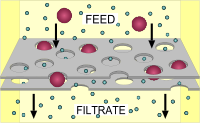
Photo from wikipedia
Dense medium separation (DMS) is of great significance for coal cleaning. The DMS control system always involves dense medium density adjustment and ash content control that are operating on fast… Click to show full abstract
Dense medium separation (DMS) is of great significance for coal cleaning. The DMS control system always involves dense medium density adjustment and ash content control that are operating on fast and slow time scales, respectively. The inherent time-varying and strongly nonlinear characteristics of the DMS process give rise to challenges for the design of this multitime scale control system. To address this issue, this article proposes a dual-rate adaptive optimal tracking control approach for the DMS system. For the basic loop process, a nonlinear adaptive PI controller containing a neural network (NN)-based unmodeled dynamics compensator is proposed. Then, a lifting technique is used to unify the time scales of the two loops accompanied by formulating a generalized controlled object, whose dynamics is completely unknown. On this basis, a data-driven operation optimization control method that combines adaptive dynamic programming algorithm and reference control is developed, which is implemented using NNs. Finally, the stability of the proposed method is analyzed. The simulation results indicate its effectiveness.
Journal Title: IEEE Transactions on Neural Networks and Learning Systems
Year Published: 2021
Link to full text (if available)
Share on Social Media: Sign Up to like & get
recommendations!